精品-高中英语语法通霸2016-英语句子结构和成分分析
- 格式:doc
- 大小:725.00 KB
- 文档页数:18
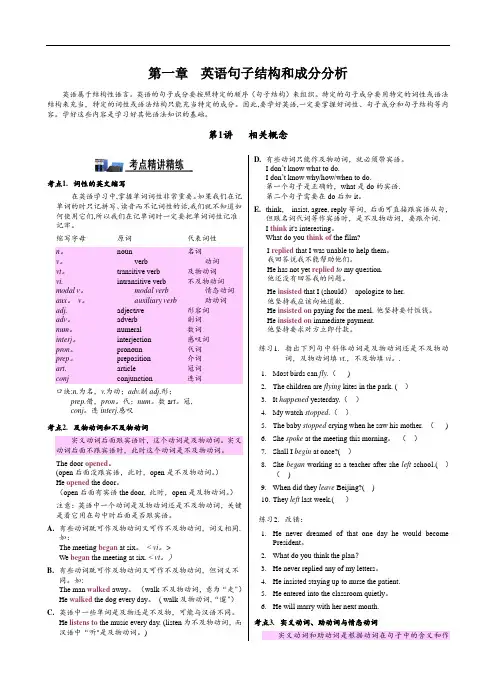
第一章英语句子结构和成分分析英语属于结构性语言。
英语的句子成分要按照特定的顺序(句子结构)来组织。
特定的句子成分要用特定的词性或语法结构来充当,特定的词性或语法结构只能充当特定的成分。
因此,要学好英语,一定要掌握好词性、句子成分和句子结构等内容。
学好这些内容是学习好其他语法知识的基础。
第1讲相关概念考点1.词性的英文缩写在英语学习中,掌握单词词性非常重要。
如果我们在记单词的时只记拼写、读音而不记词性的话,我们就不知道如何使用它们,所以我们在记单词时一定要把单词词性记准记牢。
缩写字母原词代表词性n。
noun 名词v。
verb 动词vt。
transitive verb 及物动词vi.intransitive verb 不及物动词modal v。
modal verb 情态动词aux。
v。
auxiliary verb 助动词adj.adjective 形容词adv。
adverb 副词num。
numeral 数词interj。
interjection 感叹词pron。
pronoun 代词prep。
preposition 介词art. article 冠词conj conjunction 连词口诀:n.为名,v.为动;adv.副adj.形;prep.借,pron。
代;num。
数a rt。
冠,conj。
连interj.感叹考点2.及物动词和不及物动词实义动词后面跟宾语时,这个动词是及物动词。
实义动词后面不跟宾语时,此时这个动词是不及物动词。
The door opened。
(open后面没跟宾语,此时,open是不及物动词。
)He opened the door。
(open后面有宾语the door, 此时,open是及物动词。
)注意:英语中一个动词是及物动词还是不及物动词,关键是看它用在句中时后面是否跟宾语。
A.有些动词既可作及物动词又可作不及物动词,词义相同.如:The meeting began at six。
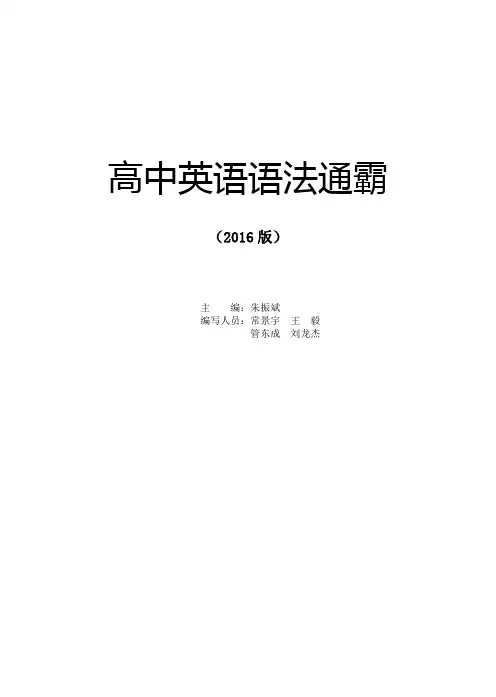
高中英语语法通霸(2016版)主编:朱振斌编写人员:常景宇王毅管东成刘龙杰前言有语言学家说过:“语言是语法化的词汇。
”也就是说,语言是按照语法规则组织起来的词汇。
一句话表达得是否正确,主要是看它是否符合语法规则;任何一个错句,都能从语法上找到原因。
因此,学好语法是学好一门语言的基础。
在当前的英语教学中,上面倡导要淡化语法教学,要重视学生综合应用能力的培养。
实施这么多年来,老师们普遍感到学生准确应用英语的能力下降了很多,特别是“写”的能力。
大部分学生写的英语作文“惨不忍睹”。
这实际上是淡化语法教学所产生的严重后果。
学习母语不学语法只要“浸泡”得多就能学好,但在我国英语毕竟是一门外语,连第二语言都不是,只靠“浸泡”而不通过学习语法知识来帮助理清规律,至少对于相当多的学生是不适用的。
一些没有学好语法的学生去美国上学,他们整天“浸泡”在英语环境中,“听”、“说”的能力提高了不少,但很多人“写”的能力却鲜有提高。
语法差的学生,总是感到自己的英语一塌糊涂。
许多学生英语从“差”中逆转过来,就是从学好语法开始的。
只有学好了语法,才能写出语法正确、句式灵活的句子来;只有学好了语法,才能读懂文章中的长难句;只有学好了语法,才能快速提高自己的“听”、“说”能力。
语法是什么?语法是帮助你解决“写”、“读”、“说”、“听”中遇到的困难的知识的总称,语法是指导你正确使用英语的精华知识。
但现在许多人都害怕英语语法。
一方面是因为现在盛行的教学理论在作怪,学校教学过于淡化语法教学,过于强调语言的“习得”,导致学生的语法基础较差。
另一方面,是因为没有合适的语法资料。
教材上的语法讲解,“千呼万唤始出来,犹抱琵琶半遮面”,总是放不下架子,就是讲一点,其深度比考试的难度要低得多,根本靠不住。
书店里的语法资料,一类是语法大家们编的,旨在解释一些语法现象,本来就不是给高中学生看的,有些知识学生看了没有用,有些知识学生根本看不懂。
再一类就是一些名校编的资料,由于编写有时间有限、稿酬是按编的页数给的,这类资料大部分粗制滥造,总是先笼统地讲解一下,再弄点题一凑就好了。
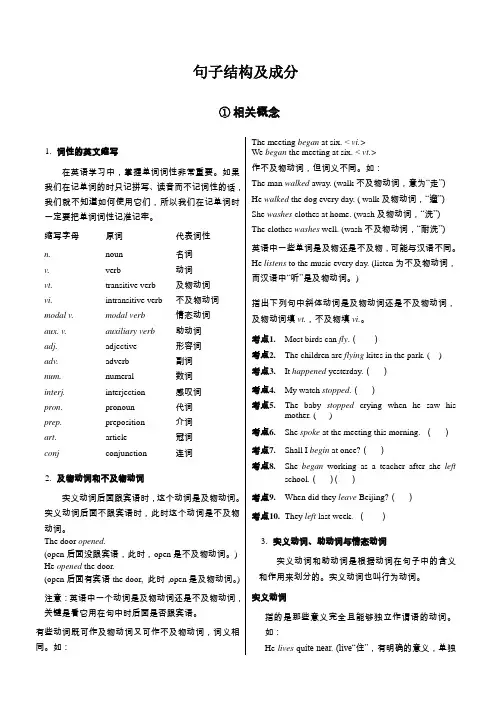
句子结构及成分①相关概念1.词性的英文缩写在英语学习中,掌握单词词性非常重要。
如果我们在记单词的时只记拼写、读音而不记词性的话,我们就不知道如何使用它们,所以我们在记单词时一定要把单词词性记准记牢。
缩写字母原词代表词性n. noun 名词v. verb 动词vt.transitive verb 及物动词vi.intransitive verb 不及物动词modal v. modal verb 情态动词aux. v. auxiliary verb 助动词adj.adjective 形容词adv.adverb 副词num. numeral 数词interj. interjection 感叹词pron. pronoun 代词prep.preposition 介词art. article 冠词conj conjunction 连词2.及物动词和不及物动词实义动词后面跟宾语时,这个动词是及物动词。
实义动词后面不跟宾语时,此时这个动词是不及物动词。
The door opened.(open后面没跟宾语,此时,open是不及物动词。
) He opened the door.(open后面有宾语the door, 此时,open是及物动词。
) 注意:英语中一个动词是及物动词还是不及物动词,关键是看它用在句中时后面是否跟宾语。
有些动词既可作及物动词又可作不及物动词,词义相同。
如:The meeting began at six. < vi.>We began the meeting at six. < vt.>作不及物动词,但词义不同。
如:The man walked away. (walk不及物动词,意为“走”) He walked the dog every day. ( walk及物动词,“遛”) She washes clothes at home. (wash及物动词,“洗”) The clothes washes well. (wash不及物动词,“耐洗”)英语中一些单词是及物还是不及物,可能与汉语不同。
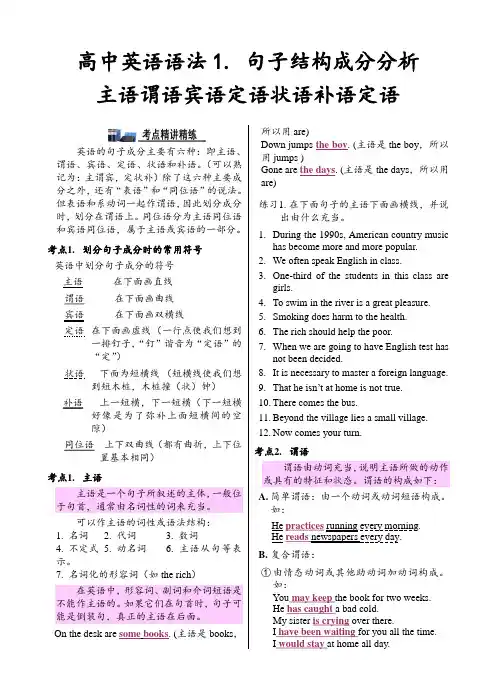
高中英语语法1. 句子结构成分分析主语谓语宾语定语状语补语定语英语的句子成分主要有六种:即主语、谓语、宾语、定语、状语和补语。
(可以熟记为:主谓宾,定状补)除了这六种主要成分之外,还有“表语”和“同位语”的说法。
但表语和系动词一起作谓语,因此划分成分时,划分在谓语上。
同位语分为主语同位语和宾语同位语,属于主语或宾语的一部分。
考点1.划分句子成分时的常用符号英语中划分句子成分的符号主语在下面画直线谓语在下面画曲线宾语在下面画双横线定语在下面画虚线(一行点使我们想到一排钉子,“钉”谐音为“定语”的“定”)状语下面为短横线(短横线使我们想到短木桩,木桩撞(状)钟)补语上一短横,下一短横(下一短横好像是为了弥补上面短横间的空隙)同位语上下双曲线(都有曲折,上下位置基本相同)考点1.主语主语是一个句子所叙述的主体,一般位于句首,通常由名词性的词来充当。
可以作主语的词性或语法结构:1. 名词2. 代词3. 数词4. 不定式5. 动名词6. 主语从句等表示。
7. 名词化的形容词(如the rich)在英语中,形容词、副词和介词短语是不能作主语的。
如果它们在句首时,句子可能是倒装句,真正的主语在后面。
On the desk are some books. (主语是books,所以用are)Down jumps the boy. (主语是the boy,所以用jumps )Gone are the days. (主语是the days,所以用are)练习1.在下面句子的主语下面画横线,并说出由什么充当。
1.During the 1990s, American country musichas become more and more popular.2.We often speak English in class.3.One-third of the students in this class aregirls.4.To swim in the river is a great pleasure.5.Smoking does harm to the health.6.The rich should help the poor.7.When we are going to have English test hasnot been decided.8.It is necessary to master a foreign language.9.That he isn’t at home is not true.10.There comes the bus.11.Beyond the village lies a small village.12.Now comes your turn.考点2.谓语谓语由动词充当,说明主语所做的动作或具有的特征和状态。
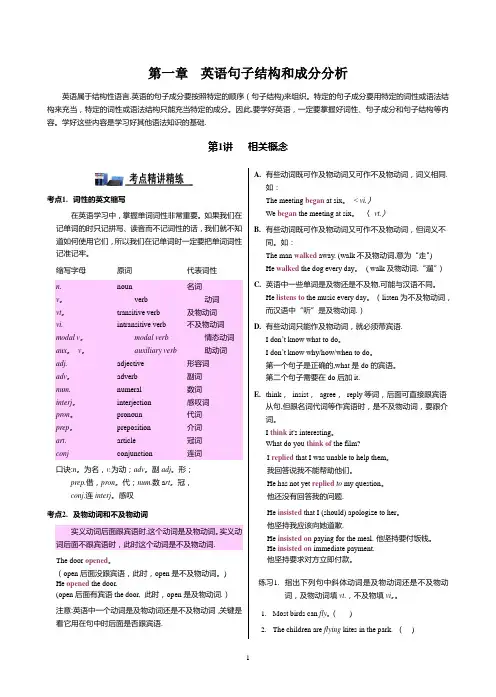
第一章英语句子结构和成分分析英语属于结构性语言.英语的句子成分要按照特定的顺序(句子结构)来组织。
特定的句子成分要用特定的词性或语法结构来充当,特定的词性或语法结构只能充当特定的成分。
因此,要学好英语,一定要掌握好词性、句子成分和句子结构等内容。
学好这些内容是学习好其他语法知识的基础.第1讲相关概念考点1.词性的英文缩写在英语学习中,掌握单词词性非常重要。
如果我们在记单词的时只记拼写、读音而不记词性的话,我们就不知道如何使用它们,所以我们在记单词时一定要把单词词性记准记牢。
缩写字母原词代表词性n. noun 名词v。
verb 动词vt。
transitive verb 及物动词vi.intransitive verb 不及物动词modal v。
modal verb 情态动词aux。
v。
auxiliary verb 助动词adj.adjective 形容词adv。
adverb 副词num. numeral 数词interj。
interjection 感叹词pron。
pronoun 代词prep。
preposition 介词art. article 冠词conj conjunction 连词口诀:n。
为名,v.为动;adv。
副adj。
形;prep.借,pron。
代;num.数a rt。
冠,conj.连interj。
感叹考点2.及物动词和不及物动词实义动词后面跟宾语时,这个动词是及物动词。
实义动词后面不跟宾语时,此时这个动词是不及物动词.The door opened。
(open后面没跟宾语,此时,open是不及物动词。
)He opened the door.(open后面有宾语the door, 此时,open是及物动词.)注意:英语中一个动词是及物动词还是不及物动词,关键是看它用在句中时后面是否跟宾语.A.有些动词既可作及物动词又可作不及物动词,词义相同.如:The meeting began at six。
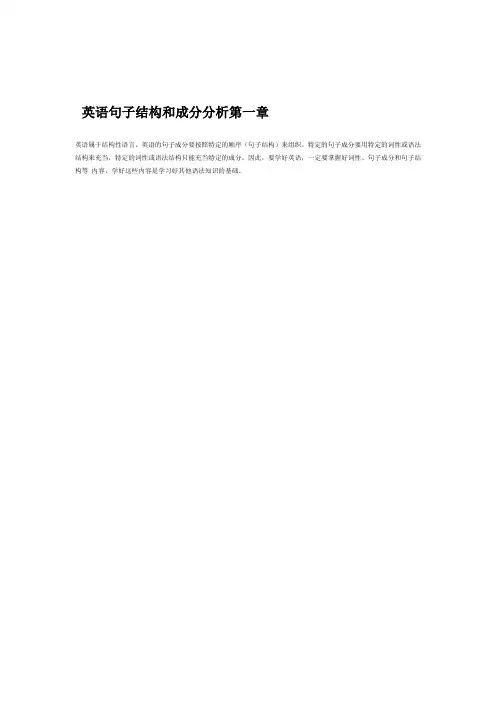
英语句子结构和成分分析第一章英语属于结构性语言。
英语的句子成分要按照特定的顺序(句子结构)来组织。
特定的句子成分要用特定的词性或语法结构来充当,特定的词性或语法结构只能充当特定的成分。
因此,要学好英语,一定要掌握好词性、句子成分和句子结构等内容。
学好这些内容是学习好其他语法知识的基础。
相关概念讲第1有些动词既可作及物动词又可作不及物动词,词义相同。
A.如:at six. < vi.>The meeting began词性的英文缩写考点1. the meeting at six. < vt.>We began在英语学习中,掌握单词词性非常重要。
如果我们在有些动词既可作及物动词又可作不及物动词,但词义不B.记单词的时只记拼写、读音而不记词性的话,我们就不知同。
如:所以我们在记单词时一定要把单词词性道如何使用它们,) away. (walk不及物动词,意为“走”The man walked记准记牢。
) 及物动词,“遛”He walked the dog every day. ( walk 原词缩写字母代表词性英语中一些单词是及物还是不及物,可能与汉语不同。
C.n. 名词noun 而为不及物动词,listens to the music every day. (listenHeverb 动词v. )汉语中“听”是及物动词。
transitive verb 及物动词vt. D.有些动词只能作及物动词,就必须带宾语。
intransitive verb vi.不及物动词t know what to do.I don't know why/how/when to do.'I don情态动词modal v. modal verb的宾语。
第一个句子是正确的,what是do aux. v. 助动词auxiliary verbit.后加do第二个句子需要在adj.adjective 形容词adverb 副词adv.等词,后面可直接跟宾语从句,think, insist, agree, reply E.数词num.numeral但跟名词代词等作宾语时,是不及物动词,要跟介词。
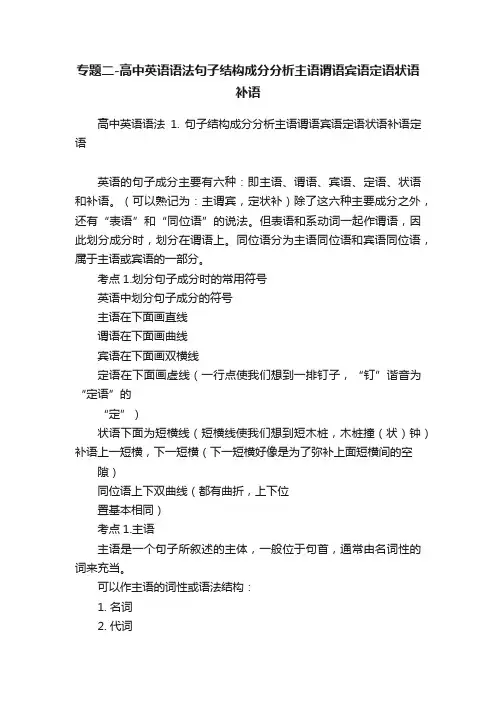
专题二-高中英语语法句子结构成分分析主语谓语宾语定语状语补语高中英语语法1. 句子结构成分分析主语谓语宾语定语状语补语定语英语的句子成分主要有六种:即主语、谓语、宾语、定语、状语和补语。
(可以熟记为:主谓宾,定状补)除了这六种主要成分之外,还有“表语”和“同位语”的说法。
但表语和系动词一起作谓语,因此划分成分时,划分在谓语上。
同位语分为主语同位语和宾语同位语,属于主语或宾语的一部分。
考点1.划分句子成分时的常用符号英语中划分句子成分的符号主语在下面画直线谓语在下面画曲线宾语在下面画双横线定语在下面画虚线(一行点使我们想到一排钉子,“钉”谐音为“定语”的“定”)状语下面为短横线(短横线使我们想到短木桩,木桩撞(状)钟)补语上一短横,下一短横(下一短横好像是为了弥补上面短横间的空隙)同位语上下双曲线(都有曲折,上下位置基本相同)考点1.主语主语是一个句子所叙述的主体,一般位于句首,通常由名词性的词来充当。
可以作主语的词性或语法结构:1. 名词2. 代词3. 数词4. 不定式5. 动名词6. 主语从句等表示。
7. 名词化的形容词(如the rich)在英语中,形容词、副词和介词短语是不能作主语的。
如果它们在句首时,句子可能是倒装句,真正的主语在后面。
On the desk are some books. (主语是books,所以用are)Down jumps the boy. (主语是the boy,所以用jumps )Gone are the days. (主语是the days,所以用are)练习1.在下面句子的主语下面画横线,并说出由什么充当。
1.During the 1990s, American country musichas become more and more popular.2.We often speak English in class.3.One-third of the students in this class aregirls.4.To swim in the river is a great pleasure.5.Smoking does harm to the health.6.The rich should help the poor.7.When we are going to have English test hasnot been decided.8.It is necessary to master a foreign language.9.That he isn’t at home is not true.10.There comes the bus.11.Beyond the village lies a small village.12.Now comes your turn.考点2.谓语谓语由动词充当,说明主语所做的动作或具有的特征和状态。
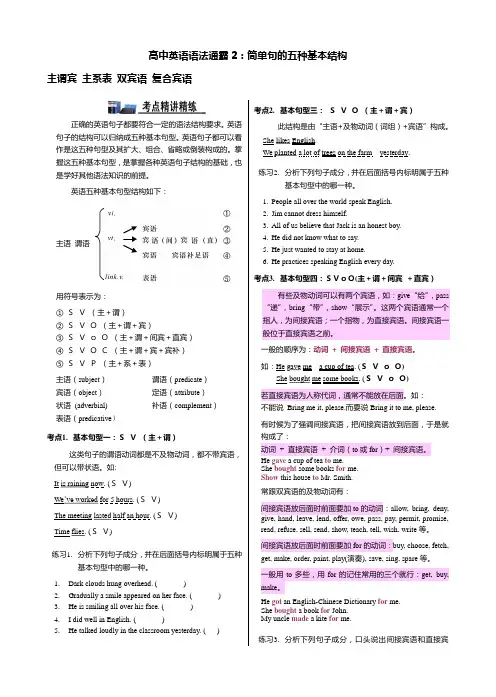
高中英语语法通霸2:简单句的五种基本结构主谓宾主系表双宾语复合宾语正确的英语句子都要符合一定的语法结构要求。
英语句子的结构可以归纳成五种基本句型。
英语句子都可以看作是这五种句型及其扩大、组合、省略或倒装构成的。
掌握这五种基本句型,是掌握各种英语句子结构的基础,也是学好其他语法知识的前提。
英语五种基本句型结构如下:主语谓语用符号表示为:①SV(主+谓)②SVO(主+谓+宾)③SVoO(主+谓+间宾+直宾)④SVOC(主+谓+宾+宾补)⑤SVP(主+系+表)主语(subject)谓语(predicate)宾语(object)定语(attribute)状语(adverbial) 补语(complement)表语(predicative)考点1.基本句型一:SV(主+谓)这类句子的谓语动词都是不及物动词,都不带宾语,但可以带状语。
如:It is raining now. (SV)We’ve worked for 5 hours. (SV)The meeting lasted half an hour. (SV)Time flies. (SV)练习1.分析下列句子成分,并在后面括号内标明属于五种基本句型中的哪一种。
1.Dark clouds hung overhead. ( )2.Gradually a smile appeared on her face. ( )3.He is smiling all over his face. ( )4.I did well in English. ( )5.He talked loudly in the classroom yesterday. ( )考点2.基本句型三:SVO(主+谓+宾)此结构是由“主语+及物动词(词组)+宾语”构成。
She likes English.We planted a lot of trees on the farm yesterday.练习2.分析下列句子成分,并在后面括号内标明属于五种基本句型中的哪一种。
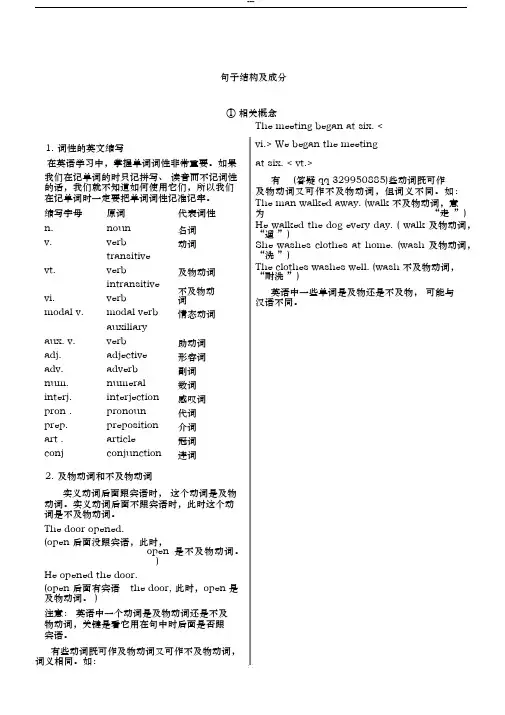
句子结构及成分① 相关概念1.词性的英文缩写在英语学习中,掌握单词词性非常重要。
如果我们在记单词的时只记拼写、读音而不记词性的话,我们就不知道如何使用它们,所以我们在记单词时一定要把单词词性记准记牢。
缩写字母原词代表词性n. noun 名词v. verb 动词vt. transitiveverb 及物动词vi. intransitiveverb不及物动词modal v. modal verb 情态动词aux. v. auxiliaryverb 助动词adj. adjective 形容词adv. adverb 副词num. numeral 数词interj. interjection 感叹词pron . pronoun 代词prep. preposition 介词art . article 冠词conj conjunction 连词2.及物动词和不及物动词实义动词后面跟宾语时,这个动词是及物动词。
实义动词后面不跟宾语时,此时这个动词是不及物动词。
The door opened.(open 后面没跟宾语,此时,open 是不及物动词。
)He opened the door.(open 后面有宾语the door, 此时,open 是及物动词。
)注意:英语中一个动词是及物动词还是不及物动词,关键是看它用在句中时后面是否跟宾语。
有些动词既可作及物动词又可作不及物动词,词义相同。
如:The meeting began at six. <vi.> We began the meetingat six. < vt.>有(答疑 qq 329950885)些动词既可作及物动词又可作不及物动词,但词义不同。
如:The man walked away. (walk 不及物动词,意为“走”) He walked the dog every day. ( walk 及物动词,“遛”)She washes clothes at home. (wash 及物动词,“洗”)The clothes washes well. (wash 不及物动词,“耐洗”)英语中一些单词是及物还是不及物,可能与汉语不同。
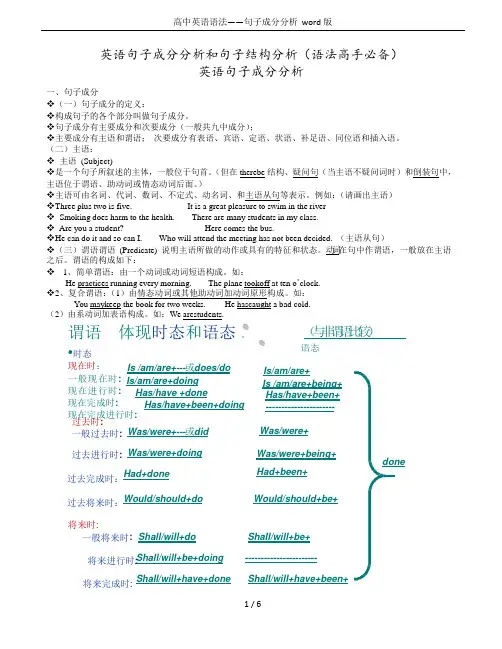
高中英语语法——句子成分分析 word 版一、句子成分英语句子成分分析和句子结构分析(语法高手必备)英语句子成分分析(一)句子成分的定义:构成句子的各个部分叫做句子成分。
句子成分有主要成分和次要成分(一般共九中成分);主要成分有主语和谓语; 次要成分有表语、宾语、定语、状语、补足语、同位语和插入语。
(二)主语: 主语 (Subject)是一个句子所叙述的主体,一般位于句首。
(但在 there b e 结构、疑问句(当主语不疑问词时)和倒装句中, 主语位于谓语、助动词或情态动词后面。
)主语可由名词、代词、数词、不定式、动名词、和主语从句等表示。
例如:(请画出主语) Three plus two is five. It is a great pleasure to swim in the river Smoking does harm to the health. There are many students in my class. Are you a student? Here comes the bus.He can do it and so can I. Who will attend the meeting has not been decided. (主语从句) (三)谓语谓语 (Predicate) 说明主语所做的动作或具有的特征和状态。
动词在句中作谓语,一般放在主语 之后。
谓语的构成如下:1、简单谓语:由一个动词或动词短语构成。
如:He practices running every morning. The plane took o ff at ten o ’clock. 2、复合谓语:(1)由情态动词或其他助动词加动词原形构成。
如:You may k eep the book for two weeks. He has c aught a bad cold.(2)由系动词加表语构成。
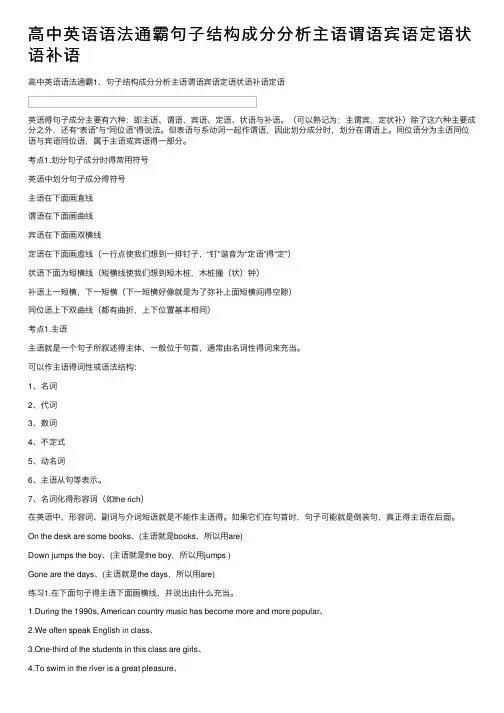
⾼中英语语法通霸句⼦结构成分分析主语谓语宾语定语状语补语⾼中英语语法通霸1、句⼦结构成分分析主语谓语宾语定语状语补语定语英语得句⼦成分主要有六种:即主语、谓语、宾语、定语、状语与补语。
(可以熟记为:主谓宾,定状补)除了这六种主要成分之外,还有“表语”与“同位语”得说法。
但表语与系动词⼀起作谓语,因此划分成分时,划分在谓语上。
同位语分为主语同位语与宾语同位语,属于主语或宾语得⼀部分。
考点1.划分句⼦成分时得常⽤符号英语中划分句⼦成分得符号主语在下⾯画直线谓语在下⾯画曲线宾语在下⾯画双横线定语在下⾯画虚线(⼀⾏点使我们想到⼀排钉⼦,“钉”谐⾳为“定语”得“定”)状语下⾯为短横线(短横线使我们想到短⽊桩,⽊桩撞(状)钟)补语上⼀短横,下⼀短横(下⼀短横好像就是为了弥补上⾯短横间得空隙)同位语上下双曲线(都有曲折,上下位置基本相同)考点1.主语主语就是⼀个句⼦所叙述得主体,⼀般位于句⾸,通常由名词性得词来充当。
可以作主语得词性或语法结构:1、名词2、代词3、数词4、不定式5、动名词6、主语从句等表⽰。
7、名词化得形容词(如the rich)在英语中,形容词、副词与介词短语就是不能作主语得。
如果它们在句⾸时,句⼦可能就是倒装句,真正得主语在后⾯。
On the desk are some books、(主语就是books,所以⽤are)Down jumps the boy、(主语就是the boy,所以⽤jumps )Gone are the days、(主语就是the days,所以⽤are)练习1.在下⾯句⼦得主语下⾯画横线,并说出由什么充当。
1.During the 1990s, American country music has become more and more popular、2.We often speak English in class、3.One-third of the students in this class are girls、4.To swim in the river is a great pleasure、5.Smoking does harm to the health、6.The rich should help the poor、7.When we are going to have English test has not been decided、8.It is necessary to master a foreign language、9.That he isn’t at home is not true、10.There comes the bus、11.Beyond the village lies a small village、12.Now comes your turn、考点2.谓语谓语由动词充当,说明主语所做得动作或具有得特征与状态。
高中英语语法通霸2:简单句的五种基本结构主谓宾主系表双宾语复合宾语正确的英语句子都要符合一定的语法结构要求。
英语句子的结构可以归纳成五种基本句型。
英语句子都可以看作是这五种句型及其扩大、组合、省略或倒装构成的。
掌握这五种基本句型,是掌握各种英语句子结构的基础,也是学好其他语法知识的前提。
英语五种基本句型结构如下:主语谓语用符号表示为:①SV(主+谓)②SVO(主+谓+宾)③SVoO(主+谓+间宾+直宾)④SVOC(主+谓+宾+宾补)⑤SVP(主+系+表)主语(subject)谓语(predicate)宾语(object)定语(attribute)状语 (adverbial) 补语(complement)表语(predicative)考点1.基本句型一:SV(主+谓)这类句子的谓语动词都是不及物动词,都不带宾语,但可以带状语。
如:It is raining now. (SV)We’ve worked for 5 hours. (SV)The meeting lasted half an hour. (SV)Time flies. (SV)练习1.分析下列句子成分,并在后面括号内标明属于五种基本句型中的哪一种。
1.Dark clouds hung overhead. ( )2.Gradually a smile appeared on her face. ( )3.He is smiling all over his face. ( )4.I did well in English. ( )5.He talked loudly in the classroom yesterday.( )考点2.基本句型三:SVO(主+谓+宾)此结构是由“主语+及物动词(词组)+宾语”构成。
She likes English.We planted a lot of trees on the farm yesterday.练习2.分析下列句子成分,并在后面括号内标明属于五种基本句型中的哪一种。
第四章句子结构及成分一.陈述句, 疑问句, 祈使句, 感叹句句子按用途可分四种:1)陈述句(肯定、否定):He is six years old; She didn’t hear of you before.2)疑问句(一般、特殊、选择、反意):Do they like skating? How old is he? Is he six or seven years old?Mary can swim, can’t she?3)祈使句:表示命令或者请求. 又叫无主句,主语通常为you,省略.Be careful, boys; Don’t talk in class4)感叹句:how 后面加上的是形容词副词.what后面加上的是名词.How clever the boy is! What a clever boy he is!二.简单句、并列句和复合句句子按结构可分为简单句、并列句和复合句。
1)简单句:只有一个主语(或并列主语)和一个谓语(或并列谓语)。
e.g. He often reads English in the morning.Tom and Mike are American boys.She likes drawing and often draws pictures for the wall newspapers.(划线部分为并列谓语,只有一个主语,仍为简单句。
)2) 并列句:由并列连词(and, but, or等)或分号(;)把两个或两个以上的简单句连在一起构成。
要注意哟,逗号是不可以连接句子的,这一点和汉语不同.e.g. You help him and he helps you.The future is bright; the road is tortuous. 前途是光明的,道路是曲折的。
1、表示连接两个同等概念,常用and, not only…but also…, neither…nor…, then等连接。
高中英语语法通霸2:简单句的五种基本结构主谓宾主系表双宾语复合宾语正确的英语句子都要符合一定的语法结构要求。
英语句子的结构可以归纳成五种基本句型。
英语句子都可以看作是这五种句型及其扩大、组合、省略或倒装构成的。
掌握这五种基本句型,是掌握各种英语句子结构的基础,也是学好其他语法知识的前提。
英语五种基本句型结构如下:主语谓语用符号表示为:①SV(主+谓)②SVO(主+谓+宾)③SVoO(主+谓+间宾+直宾)④SVOC(主+谓+宾+宾补)⑤SVP(主+系+表)主语(subject)谓语(predicate)宾语(object)定语(attribute)状语 (adverbial) 补语(complement)表语(predicative)考点1.基本句型一:SV(主+谓)这类句子的谓语动词都是不及物动词,都不带宾语,但可以带状语。
如:It is raining now. (SV)We’ve worked for 5 hours. (SV)The meeting lasted half an hour. (SV)Time flies. (SV)练习1.分析下列句子成分,并在后面括号内标明属于五种基本句型中的哪一种。
1.Dark clouds hung overhead. ( )2.Gradually a smile appeared on her face. ( )3.He is smiling all over his face. ( )4.I did well in English. ( )5.He talked loudly in the classroom yesterday.( )考点2.基本句型三:SVO(主+谓+宾)此结构是由“主语+及物动词(词组)+宾语”构成。
She likes English.We planted a lot of trees on the farm yesterday.练习2.分析下列句子成分,并在后面括号内标明属于五种基本句型中的哪一种。
第一章英语句子结构和成分分析英语属于结构性语言。
英语的句子成分要按照特定的顺序(句子结构)来组织。
特定的句子成分要用特定的词性或语法结构来充当,特定的词性或语法结构只能充当特定的成分。
因此,要学好英语,一定要掌握好词性、句子成分和句子结构等内容。
学好这些内容是学习好其他语法知识的基础。
第1讲相关概念考点1.词性的英文缩写在英语学习中,掌握单词词性非常重要。
如果我们在记单词的时只记拼写、读音而不记词性的话,我们就不知道如何使用它们,所以我们在记单词时一定要把单词词性记准记牢。
缩写字母原词代表词性n. noun 名词v. verb 动词vt.transitive verb 及物动词vi.intransitive verb 不及物动词modal v. modal verb 情态动词aux. v. auxiliary verb 助动词adj.adjective 形容词adv.adverb 副词num. numeral 数词interj. interjection 感叹词pron. pronoun 代词prep.preposition 介词art. article 冠词conj conjunction 连词口诀:n.为名,v.为动;adv.副adj.形;prep.借,pron.代;num.数a rt.冠,conj.连interj.感叹考点2.及物动词和不及物动词实义动词后面跟宾语时,这个动词是及物动词。
实义动词后面不跟宾语时,此时这个动词是不及物动词。
The door opened.(open后面没跟宾语,此时,open是不及物动词。
)He opened the door.(open后面有宾语the door, 此时,open是及物动词。
)注意:英语中一个动词是及物动词还是不及物动词,关键是看它用在句中时后面是否跟宾语。
A.有些动词既可作及物动词又可作不及物动词,词义相同。
如:The meeting began at six. < vi.>We began the meeting at six. < vt.>B.有些动词既可作及物动词又可作不及物动词,但词义不同。
如:The man walked away. (walk不及物动词,意为“走”)He walked the dog every day. ( walk及物动词,“遛”)C.英语中一些单词是及物还是不及物,可能与汉语不同。
He listens to the music every day. (listen为不及物动词,而汉语中“听”是及物动词。
)D.有些动词只能作及物动词,就必须带宾语。
I don’t know what to do.I don’t know why/how/when to do.第一个句子是正确的,what是do的宾语。
第二个句子需要在do后加it.E.think, insist, agree, reply等词,后面可直接跟宾语从句,但跟名词代词等作宾语时,是不及物动词,要跟介词。
I think it’s interesting.What do you think of the film?I replied that I was unable to help them.我回答说我不能帮助他们。
He has not yet replied to my question.他还没有回答我的问题。
He insisted that I (should) apologize to her.他坚持我应该向她道歉。
He insisted on paying for the meal. 他坚持要付饭钱。
He insisted on immediate payment.他坚持要求对方立即付款。
练习1.指出下列句中斜体动词是及物动词还是不及物动词,及物动词填vt.,不及物填vi.。
1.Most birds can fly.()2.The children are flying kites in the park. ( )3.It happened yesterday.()4.My watch stopped.()5.The baby stopped crying when he saw his mother. ( )6.She spoke at the meeting this morning. ()7.Shall I begin at once?()8.She began working as a teacher after she left school.()()9.When did they leave Beijing?()10.They left last week.()练习2.改错:1.He never dreamed of that one day he would becomePresident.2.What do you think the plan?3.He never replied any of my letters.4.He insisted staying up to nurse the patient.5.He entered into the classroom quietly.6.He will marry with her next month.考点3.实义动词、助动词与情态动词实义动词和助动词是根据动词在句子中的含义和作用来划分的。
实义动词也叫行为动词。
实义动词指的是那些意义完全且能够独立作谓语的动词。
如:He lives quite near. (live“住”,有明确的意义,单独作谓语,为实义动词。
)I like reading. (like “喜欢”,意思明确,单独作谓语,为实义动词。
)I bought a pen yesterday. (bought“买”,意义明确,单独作谓语,为实义动词。
)助动词助动词的“助”是“帮助”之意。
因此,助动词是指那些用来帮助构成时态、语态、虚拟语气、疑问句、否定句、倒装句和帮助强调的词。
这些词本身无词汇意义或意义不完全,不能单独作谓语。
A.帮助构成时态的:The boy is crying. (is 用来帮助构成现在进行时,和crying 一起作谓语,是助动词。
)He has arrived. (has用来帮助构成现在完成时,和arrived 一起作谓语,是助动词。
)I have been painting all day. (have been用来帮助构成现在完成进行时,和painting一起作谓语,都是助动词。
)B.帮助构成否定句和疑问句的:Does he like English? (does帮助构成一般疑问句,没有具体意义,是助动词。
)He does n’t have lunch at home.(does只是帮助构成否定句,没有具体意义,是助动词。
) C.帮助构成被动语态的Trees are planted in spring. (are帮助构成被动语态,没有具体意义,是助动词。
)The house has been pulled down. (has been帮助构成时态和语态,是助动词。
)D.帮助构成虚拟语气If he had come yesterday, I would n’t have made such amistake.(had, have帮助构成虚拟语气,是助动词,属于谓语的一部分。
)E.帮助构成倒装句的So much did he love his mother that he bought her manypresents on her birthday.(他如此爱他的母亲以至于他母亲生日那一天,他给她买了许多礼物。
did只是帮助构成倒装句,没有具体意义,是助动词。
)F.帮助构成强调意义的He did come yesterday. (他昨天确实来过。
did起强调作用,没有具体意义,是助动词。
)因此可以看出,常见的助动词为do, be, hav e,它们为基本助动词。
一个词既可以作实义动词也可以作助动词,具体是哪一种,主要看它们在句中的功能。
①He did his homework at seven o’clock. (did单独作谓语,意为“做”,是实义动词。
)Did he do his homework yesterday? (did是助动词,帮助构成一般疑问句,do是实义动词,意为“做”,是实义动词。
)②He has had breakfast. (has是助动词,帮助构成现在完成时,had是实义动词,意为“吃”。
has had一起构成了句子的谓语。
)练习3.指出下列斜体单词是实义动词还是助动词。
1.Does ( ) he like ( ) swimming?2.He does ( ) like ( ) swimming.3.Where does( ) he live ( )?4.He does ( ) some washing after work.5.He has ( ) had ( ) supper already.6.The bridge has( ) been( ) built( ) now.7.I have ( ) been ( )waiting( ) for you all day.8.He was ( ) struck ( ) by a stone.情态动词情态动词同助动词一样,不能单独作谓语,要和实义动词一起作谓语。
因此,情态动词也称为情态助动词。
情态动词同基本助动词的区别在于,基本助动词本身无意义,而情态动词有自己的意义。
如:He can swim across the river. (can的词义为“能够”)You must stay at home. (must词义为“必须”)I might leave tomorrow.(might的词义为“或许”)第2讲句子成分英语的句子成分主要有六种:即主语、谓语、宾语、定语、状语和补语。
(可以熟记为:主谓宾,定状补)除了这六种主要成分之外,还有“表语”和“同位语”的说法。
但表语和系动词一起作谓语,因此划分成分时,划分在谓语上。
同位语分为主语同位语和宾语同位语,属于主语或宾语的一部分。
考点4.划分句子成分时的常用符号英语中划分句子成分的符号主语在下面画直线谓语在下面画曲线宾语在下面画双横线定语在下面画虚线(一行点使我们想到一排钉子,“钉”谐音为“定语”的“定”)状语下面为短横线(短横线使我们想到短木桩,木桩撞(状)钟)补语上一短横,下一短横(下一短横好像是为了弥补上面短横间的空隙)同位语上下双曲线(都有曲折,上下位置基本相同)考点1.主语主语是一个句子所叙述的主体,一般位于句首,通常由名词性的词来充当。